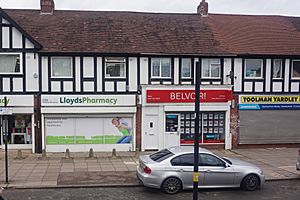Gilbertstone facts for kids
Gilbertstone is a neighborhood in Birmingham, West Midlands, England. It's a place where people live, located between the areas of Yardley and South Yardley.
Contents
What's in a Name? The Story of Gilbertstone
No one knows for sure how Gilbertstone got its name. But there's a cool local story! It says a man named Gilbert once moved a huge stone. He did this to change the border of his land and get more space.
This special stone is believed to be from the Ice Age. It's called a glacial erratic because it was moved by a glacier. Today, you can see this stone at Blakesley Hall in Yardley.
Gilbertstone's Past: From Farmhouse to Neighborhood
Gilbertstone was first shown as a separate place from Yardley on an old map by John Ogilby. This map showed the Coventry Road. The area really started to grow when Gilbertstone House was built.
Gilbertstone House: A Grand Home
Gilbertstone House was a large home built between 1866 and 1867. It was built for Samuel Thornley on the spot where a small farmhouse used to be. Later, in 1883, Richard Tangye bought the house. He was a big supporter of the Birmingham Art Gallery.
The house had huge grounds that stretched into other areas like Lyndon End. It even had a pool with a boathouse! There was also a tall tower, about 65-foot (20 m) high, attached to the side of the house. In 1905, records showed that this big house and its land were located across two different counties: Warwickshire and Worcestershire.
Building the Community
Thomas Rowbotham lived in Gilbertstone House for a while. He helped develop the roads nearby. He even gave land for a church, St. Michael and All Angels, though the church was built on a different spot later. He also sold land for new buildings.
Sir Hanson Rowbotham later sold the entire estate for £250,000. The grand house was taken down in 1937. The plan was to build 3,000 houses on the 300-acre (1.2 km2) estate. However, World War II stopped this building project.
Famous Visitors and Old Landmarks
Some important people visited the farmhouse and the manor house over the years. These included John Bright, Catherine Hutton (daughter of historian William Hutton), and members of the Royal Colonial Institute.
Today, the land where the estate once stood is crossed by streets like Saxondale Avenue, Sunnymead Road, and parts of Wensley Road. Manor House Lane reminds us of the old estate. Moat Lane, which borders Gilbertstone, gets its name from one of two old moats in the area. You can still see parts of this moat in Gilbertstone Recreation Ground.
After the War: Rebuilding Gilbertstone
During World War II, Gilbertstone was hit by bombs from the Luftwaffe (the German air force). After the war ended, the area was rebuilt. A new housing estate with 576 houses was constructed in Gilbertstone. About 36% of these houses were designed by architects approved by the RIBA.
Gilbertstone Primary School: A New Start
In 1950, Gilbertstone got its own primary school. It was designed in a typical style for buildings made after the war. The school buildings were actually moved from another school in Acocks Green and put back together in Gilbertstone!
These wooden buildings were taken down in 1998 because they were not safe anymore. New buildings were started in 1998 and opened on March 24, 2000, by Estelle Morris. The school was able to build these new facilities thanks to money from Birmingham International Airport.
Gilbertstone Today
Today, Gilbertstone is a small neighborhood within the larger areas of Yardley and South Yardley. It has Gilbertstone Primary School, which teaches children from nursery up to junior grades. The school can have up to 400 students.
There's also a large green space called Gilbertstone Recreation Ground. This park is used by Tennis For Free, a charity that helps people play tennis for no cost.


